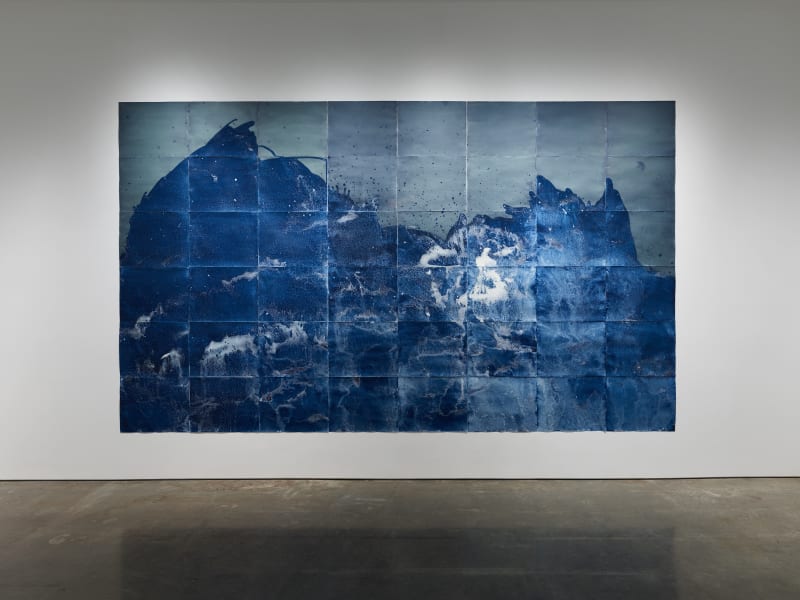JTF (just the facts): A total of 14 photographic works, framed in white and unmatted or unframed and pinned directly to the wall, and displayed against white walls in the East and West galleries and small hallway alcove. All of the works are dynamic (partially fixed) cyanotypes, made in 2015 and 2016. Each work consists of between 1 and 48 panels (most are 1, 2, or 3 panels), each element ranging in size from roughly 19×24 to 60×42. All of the works are unique.
Comments/Context: While hand-crafted one-of-a-kind photographic processes have proven to be a seductive alternative to the machined perfection of digital techniques for many contemporary photographers, the conceptual permutations of process exploration haven't necessarily ended with the rediscovery of an arcane set of chemical formulas. For some, the very process of making a picture in these forgotten effort-intensive ways has become wholly embedded in the outcomes, allowing and encouraging external elements and natural forces to be inextricably interwoven with the imagery being captured. The result is a growing group of photographic works that intimately respond to and are part of their subjects, offering a directness of physical experience that feels altogether closer than the normal mediation of the camera.
Meghann Riepenhoff's cyanotypes fit neatly into this burgeoning category. Not only do her ethereal blue works leverage the same photosensitive process that Anna Atkins used to make her plant studies at the dawn of the medium, they force that ancient process to combine with modern day nature in ways that emphasize tactile interaction and shifting impermanence. She dunks her treated papers in salt water waves, hangs them over tree branches in rainstorms, and buries them in melting ice, allowing the natural processes and chance deposits of salt, sand, dirt, and other materials to participate in generating her patterns and abstractions.
Movement pays a critical role in these works, both on the part of Riepenhoff herself and by the wildness and unpredictability of her natural collaborators. Waves spill over the paper, creating fluid sweeps of color that swirl and crash in frothy churning pools - in one case, the force of the wave motion has generated a Hokusai-like tower of water, while in another, the roiled up sand and salt have added splotchy spots and pinprick highlights to the subtle shades of blue.
Other works rely on streaming raindrops to be the active visual catalyst. Riepenhoff's treated papers have been draped over branches or seemingly folded over square platforms - when the rains come, the water lands on the high points and then drips downward, creating rivulets and spills in whiter shades of blue that cascade in jittery parallel lines. Depending on how the supporting branch is oriented, the works end up with bold Barnett Newman-like vertical zips (with feathery horizontal streams) or various other angled alignments, and changes in the weather offer soft drops that pock mark the surface or more violent, expressive storms of fluid that spray with more obvious intensity. A few of the works recall the performative darkroom experiments of Mariah Robertson, their forms filled with the same kind of theatrical energy.
Once we start thinking about them, these kinds of echoes and connections draw Riepenhoff into dialogue with a number of contemporary artists. Susan Derges has consistently used the flow of water to create photographic works, making elegant photogram silhouettes in rippling stream beds. Matthew Brandt has repeatedly brought physical manifestations of his images into their production, from developing landscapes in lake water to baking skeletal images in the black gunk found in tar pits. And Chris McCaw has made long exposure sun and moon trails, the light from those celestial bodies often burning the paper on which they are recorded. In their own ways, each has embraced the ability of nature to actively participate in the innovative creation of artworks.
Riepenhoff's unique contributions to this genre come in her willingness to let nature be the mark maker. While she has clearly laid out the geometries of certain images, placed the papers in the water to achieve a certain balance between wet and dry, and ultimately decided when a work was "done", the principal actor in each picture is the falling of rain or the ebb and flow of the tides. As you stand in the gallery in front of these works, that uneasy collaboration feels elemental and wild, and the chance outcomes that are produced during the process further remind us of the mutability of her approach. Each work represents the specific mix of conditions at a particular moment in time, each a fleeting representation of forces that are inherently uncontrollable.

